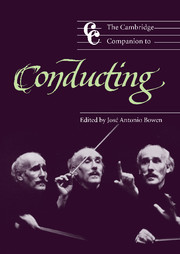10 - The French tradition
from Part II - History
Published online by Cambridge University Press: 28 September 2011
Summary
To trace anything as definite as a tradition, even in one country, with an activity as egoistic as conducting, is a delicate and hazardous task. Realistically considered, perhaps, the French tradition boils down to a list of conductors, from Jean-Baptiste Lully (1632–87) to Pierre Boulez (b. 1925) – the former keeping time by thumping the ground with the long stick which was to cause his death from gangrene when he inadvertently jammed the point into his toe, the latter shaping complex meters with batonless hands, and still, happily, very much with us.
True, conductors tend in practice to be conservative people (though the opposite is the case with two of the greatest, Berlioz and Boulez). They can often be shown to have reproduced quite closely what they grew up learning to do: making the same cuts and the same ritardandos and accelerandos as their mentors did, omitting the same exposition repeats, and so on. Even then, however, the reproduction, colored by the mind and temperament of the individual concerned, is likely to take on a new character and become something different. Tradition, as Stravinsky's dictum has it, is made, not inherited.
- Type
- Chapter
- Information
- The Cambridge Companion to Conducting , pp. 134 - 145Publisher: Cambridge University PressPrint publication year: 2003

